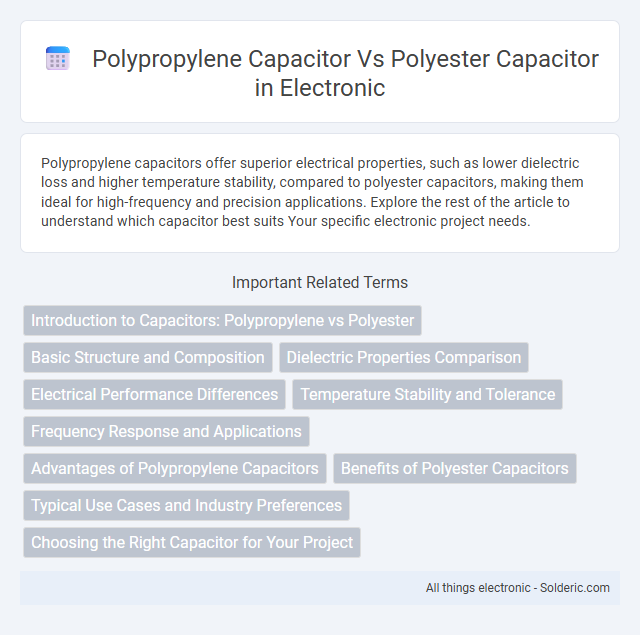Polypropylene capacitors offer superior electrical properties, such as lower dielectric loss and higher temperature stability, compared to polyester capacitors, making them ideal for high-frequency and precision applications. Explore the rest of the article to understand which capacitor best suits Your specific electronic project needs.
Comparison Table
| Feature | Polypropylene Capacitor | Polyester Capacitor |
|---|---|---|
| Dielectric Material | Polypropylene (PP) | Polyester (PET) |
| Dielectric Constant | 2.2 - 2.3 | 3.2 - 3.4 |
| Temperature Stability | Excellent (up to 105degC) | Good (up to 85degC) |
| Tolerance | +-1% to +-5% | +-5% to +-10% |
| Insulation Resistance | Very High | Moderate |
| Dielectric Loss (tan d) | Low (0.0002) | Higher (0.02) |
| Frequency Response | High frequency applications | Low to medium frequency |
| Cost | Higher | Lower |
| Typical Applications | Precision circuits, filters, high-frequency tuning | General purpose, coupling, timing circuits |
| Lifespan | Longer | Shorter |
Introduction to Capacitors: Polypropylene vs Polyester
Polypropylene capacitors offer superior electrical stability, low dielectric loss, and high insulation resistance compared to polyester capacitors, making them ideal for precision circuits and high-frequency applications. Polyester capacitors provide a cost-effective solution with good dielectric strength and moderate temperature tolerance, often used in general-purpose electronic devices. Your choice between these capacitor types depends on the required performance, frequency range, and application environment.
Basic Structure and Composition
Polypropylene capacitors consist of a dielectric layer made from stretched polypropylene film, combined with metallic foil electrodes, providing low dielectric loss and high insulation resistance. Polyester capacitors use polyethylene terephthalate (PET) film as the dielectric material, offering higher dielectric constant but increased dielectric absorption compared to polypropylene. The structural differences impact their electrical properties, with polypropylene capacitors favored for precision applications due to superior stability and polyester capacitors preferred in cost-sensitive general-purpose uses.
Dielectric Properties Comparison
Polypropylene capacitors exhibit superior dielectric properties with a low dielectric constant around 2.2, low dielectric loss, and high insulation resistance, making them ideal for high-frequency and precision applications. Polyester capacitors, with a higher dielectric constant of approximately 3.3, have increased permittivity but suffer from higher dielectric losses and lower insulation resistance compared to polypropylene types. The lower dissipation factor and excellent stability of polypropylene capacitors enhance their performance in applications requiring minimal energy loss and stable capacitance over temperature variations.
Electrical Performance Differences
Polypropylene capacitors exhibit lower dielectric loss, higher insulation resistance, and superior stability over a wide frequency range compared to polyester capacitors, making them ideal for high-frequency and precision applications. Polyester capacitors, while offering higher capacitance per volume and lower cost, tend to have increased dielectric losses, higher leakage currents, and less dielectric strength. The self-healing properties and low dissipation factor of polypropylene capacitors enhance their performance in circuits requiring low noise and high reliability.
Temperature Stability and Tolerance
Polypropylene capacitors exhibit superior temperature stability with minimal capacitance variation across a broad temperature range, typically from -55degC to 105degC, making them ideal for precision applications requiring tight tolerance. Polyester capacitors, while more cost-effective, show greater capacitance changes and lower temperature limits, usually around -40degC to 85degC, which can affect circuit reliability in high-temperature environments. Your choice between these capacitors should consider the required operating temperature and tolerance precision to ensure optimal performance.
Frequency Response and Applications
Polypropylene capacitors exhibit superior frequency response due to their low dielectric loss and stability at high frequencies, making them ideal for RF circuits, audio equipment, and precision filtering applications. Polyester capacitors, while cost-effective and suitable for general-purpose use, have higher dielectric losses and limited frequency response, restricting their use to low-frequency applications such as power supplies and coupling circuits. The choice between these capacitors hinges on performance requirements, where polypropylene capacitors dominate in high-frequency and high-precision environments.
Advantages of Polypropylene Capacitors
Polypropylene capacitors offer superior electrical stability and lower dielectric losses compared to polyester capacitors, making them ideal for high-frequency applications. Their excellent temperature tolerance and high insulation resistance enhance performance and reliability in precision circuits. You benefit from longer lifespan and better voltage handling when choosing polypropylene capacitors over polyester types.
Benefits of Polyester Capacitors
Polyester capacitors offer superior flexibility and durability compared to polypropylene capacitors, making them ideal for applications requiring resilience to mechanical stress and vibration. They provide excellent electrical insulation and stable capacitance over a wide temperature range, enhancing the reliability of your electronic circuits. Their cost-effectiveness and smaller size make polyester capacitors a practical choice for compact, budget-sensitive designs.
Typical Use Cases and Industry Preferences
Polypropylene capacitors are preferred in high-frequency filtering, precision timing circuits, and audio applications due to their low dielectric loss and excellent stability. Polyester capacitors are commonly used in general-purpose electronics, such as coupling, decoupling, and low-cost signal processing, where moderate performance is acceptable. Your choice between these capacitors depends on the required electrical characteristics and industry standards, with polypropylene favored in demanding environments and polyester chosen for cost-effective, everyday applications.
Choosing the Right Capacitor for Your Project
Polypropylene capacitors offer superior electrical characteristics such as low dielectric loss, high insulation resistance, and excellent stability over temperature, making them ideal for precision filtering and timing applications. Polyester capacitors provide cost-effective solutions with higher capacitance per volume but have higher dissipation factors and less stability, suitable for general-purpose uses where tight tolerance is not critical. Your choice between polypropylene and polyester capacitors depends on balancing performance requirements and budget constraints in your specific electronic project.
polypropylene capacitor vs polyester capacitor Infographic

 solderic.com
solderic.com